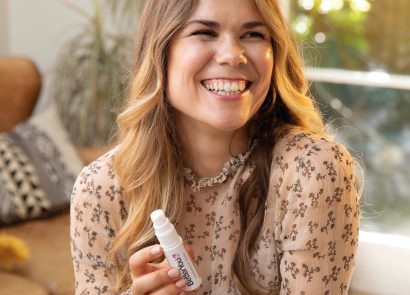Just how true are these old wives’ tales? We put them to the experts to find out
Does plucking one grey hair really mean that more will grow back in its place? And, what about shaving – will hair actually grow back thicker? It’s easy to believe these common beauty myths because it’s what we’ve been told since we were young, but how much truth is actually behind these statements? We called in the beauty pros to discover just how accurate these myths are – here’s what they said…
The myth: You should never put oil on oily skin
What the experts say: “Avoiding oil-based products on oily skin is actually a myth, yet many people still make the assumption that you shouldn’t use them,” explains Dr Preema Vig, medical director of the Dr Preema London Clinic (drpreema.com). “There are a variety of pure and blended oil formulations which combine antioxidants or additional ingredients, such as vitamin A or E, and can actually balance the skin to address over production of sebum and oils. You will be able to find an oil which will nourish the skin without making it overly oily. New face oils won’t give you spots as they are lightweight, absorb quickly and don’t clog pores – in fact, plant-based oils can help combat breakouts as they work to rebalance the skin. Generally, good-quality facial oils will massage into the skin without leaving a residue. Any excess can be removed by lightly pressing a clean sheet of tissue before applying make-up.”
The myth: You can get rid of cellulite
What the experts say: “Cellulite is a condition in which the skin has a dimpled appearance, usually affecting the buttocks, arms and thighs,” says dermatologist Dr Gabriel Serrano, founder of Sesderma (sesderma.co.uk). “Cellulite occurs when fat deposits push through the connective tissue beneath the skin. Unless you undergo extensive surgery, it’s hard to permanently rid yourself of cellulite. However, there are some things that you can do to help treat the appearance and prevent re-occurrence, such as exfoliation and regular exercise, as toning up the muscles in your legs can help to improve the appearance of cellulite. Using a body brush regularly in the shower, focusing on the buttocks, arms and leg areas, will help because the stimulation can help detox and reduce the appearance of cellulite. It’s worth investing in a vitamin C body cream, such as Sesderma C-Vit Radiant Body Milk (£15.60, sesderma.co.uk), as this helps to produce collagen which can plump up the skin, as well as repairing red blood cells which can help to reduce the appearance of cellulite. The antioxidant properties can also help to reduce the appearance of cellulite.”
The myth: Expensive skincare is more effective
What the experts say: “This is not necessarily true,” Dr Preema tells us. “When looking at skincare, you should look at the ingredients, rather than the price points or brands. Higher-end skincare companies often include their own proprietary blend of ingredients in their products, which can be sourced from labs exclusive to them – this is why the price point can be higher. Cheaper skincare products can work just as well if they have the right ingredients that you need for your particular skin type.”
The myth: You should exfoliate daily
What the experts say: “This is a definite no,” states Karen J. Gerrard, founder of SEAMS Hand Cream (seamsbeauty.co.uk). “While it’s great to exfoliate once or twice a week to remove dead skin cells and smooth skin as it helps products to be more easily absorbed, over-exfoliating will strip the skin of its natural oils and can cause skin to become red and inflamed. You need to give your skin the time to rejuvenate before stripping it down.”
The myth: You can repair split ends
What the experts say: “Unfortunately, you can’t mend split ends – the only cure is to cut them off,” says trichologist Anabel Kingsley (philipkingsley.co.uk). “However, there’s a lot that you can do to avoid getting them. Firstly, use a weekly pre-shampoo conditioner to strengthen your hair. This will make your strands more resilient, and so they will be less likely to split. Secondly, avoid handling your hair in a way that encourages the formation of split ends. One of the worst offenders is the repeated use of rough bristle brushes. They can gradually wear away your hair’s protective outer layer (its cuticle), causing the ends of your hair to fracture. Choose a vented brush with rounded, plastic prongs that is gentle on both the hair and scalp.”
The myth: Plucking one grey hair will mean that several will grow in its place
What the experts say: “Luckily, this is just a myth,” says Lizzie Carter, founder and director of Only Curls (onlycurls.com). “However, when you pluck any hair, if the scalp and hair is healthy, it will be replaced, and if this is a grey hair where the pigment cannot be reproduced, another grey one will replace it. Each strand of hair has its own follicle in the scalp, so removing just one hair does not physically cause an influx. It’s not recommended to pluck hairs if possible, as this can lead to damaged hair follicles.”
The myth: Hair can get used to a product, making it less effective
What the experts say: “The efficacy of a product doesn’t change over time,” states Jennifer Hirsch, beauty botanist for 97 percent natural brand Noughty Haircare (noughtyhaircare.co.uk). “Instead, one of two things might be happening. Build-up may be affecting the results you’re getting from all your hair products. A clarifying shampoo, such as Noughty’s Detox Dynamo (£6.99, noutyhaircare.co.uk), that’s rich in chelating ingredients, will lift away build-up from products, pollution and even hard water, allowing your normal products to work effectively. Alternatively, it may be that the condition of your hair and what it needs has changed. If you are using a product to address a specific issue and the product is good, it should improve that issue over time.”
The myth: Cutting hair regularly enhances growth
What the experts say: “Cutting your hair regularly doesn’t impact the rate of growth, there are a number of factors that determine this. However, regular trimming of the hair does keep it in good condition, especially on longer styles where the ends of the hair suffer most damage,” says trichologist Eva Proudman. “Genetically, you inherit the anagen growing phase which can last between two to five years, and the rate of growth varies from 0.5cm-1.5cm per month. Diet and lifestyle also play a part in keeping the growth cycle healthy. Using a stimulating shampoo will help your hair to grow as healthily as possible due to the micro circulation being stimulated, which brings the blood to the surface and encourages the follicles to be active.”
The myth: Shaving makes hair grow back thicker and darker
What the experts say: “Shaving does not fundamentally change the structure of the hair,” says Dr Ross Perry, dermatologist, GP and owner of skin clinics chain Cosmedics (cosmedics.co.uk). “However, regrowth can certainly feel different as the shaved edge of the hair tends to be sharper and thicker than the thinner and tapered end of a natural unshaved hair. When you shave an area, you have potentially hundreds of these blunted ends, which leaves the skin feeling bristly and stubbly. Hair removal techniques such as waxing or epilation remove hair at the root rather than cutting it off, so regrowth feels softer. So does laser hair removal – with the added benefit that less hair will regrow.”





















